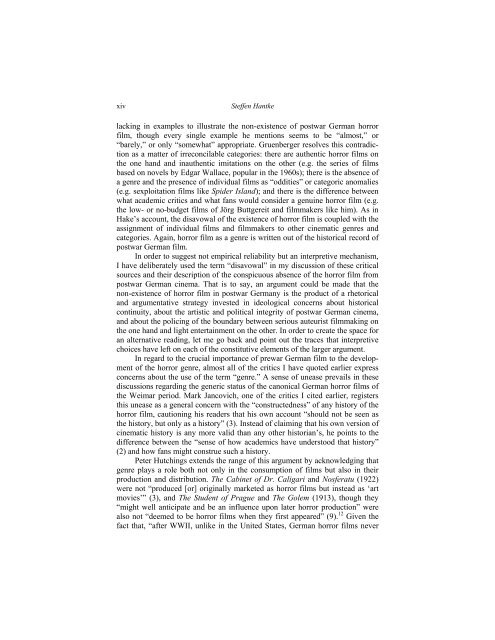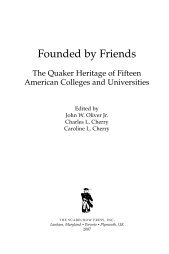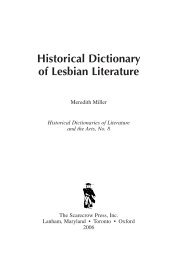Postwar German Cinema and the Horror Film - Scarecrow Press
Postwar German Cinema and the Horror Film - Scarecrow Press
Postwar German Cinema and the Horror Film - Scarecrow Press
Create successful ePaper yourself
Turn your PDF publications into a flip-book with our unique Google optimized e-Paper software.
xiv Steffen Hantke<br />
lacking in examples to illustrate <strong>the</strong> non-existence of postwar <strong>German</strong> horror<br />
film, though every single example he mentions seems to be “almost,” or<br />
“barely,” or only “somewhat” appropriate. Gruenberger resolves this contradiction<br />
as a matter of irreconcilable categories: <strong>the</strong>re are au<strong>the</strong>ntic horror films on<br />
<strong>the</strong> one h<strong>and</strong> <strong>and</strong> inau<strong>the</strong>ntic imitations on <strong>the</strong> o<strong>the</strong>r (e.g. <strong>the</strong> series of films<br />
based on novels by Edgar Wallace, popular in <strong>the</strong> 1960s); <strong>the</strong>re is <strong>the</strong> absence of<br />
a genre <strong>and</strong> <strong>the</strong> presence of individual films as “oddities” or categoric anomalies<br />
(e.g. sexploitation films like Spider Isl<strong>and</strong>); <strong>and</strong> <strong>the</strong>re is <strong>the</strong> difference between<br />
what academic critics <strong>and</strong> what fans would consider a genuine horror film (e.g.<br />
<strong>the</strong> low- or no-budget films of Jörg Buttgereit <strong>and</strong> filmmakers like him). As in<br />
Hake’s account, <strong>the</strong> disavowal of <strong>the</strong> existence of horror film is coupled with <strong>the</strong><br />
assignment of individual films <strong>and</strong> filmmakers to o<strong>the</strong>r cinematic genres <strong>and</strong><br />
categories. Again, horror film as a genre is written out of <strong>the</strong> historical record of<br />
postwar <strong>German</strong> film.<br />
In order to suggest not empirical reliability but an interpretive mechanism,<br />
I have deliberately used <strong>the</strong> term “disavowal” in my discussion of <strong>the</strong>se critical<br />
sources <strong>and</strong> <strong>the</strong>ir description of <strong>the</strong> conspicuous absence of <strong>the</strong> horror film from<br />
postwar <strong>German</strong> cinema. That is to say, an argument could be made that <strong>the</strong><br />
non-existence of horror film in postwar <strong>German</strong>y is <strong>the</strong> product of a rhetorical<br />
<strong>and</strong> argumentative strategy invested in ideological concerns about historical<br />
continuity, about <strong>the</strong> artistic <strong>and</strong> political integrity of postwar <strong>German</strong> cinema,<br />
<strong>and</strong> about <strong>the</strong> policing of <strong>the</strong> boundary between serious auteurist filmmaking on<br />
<strong>the</strong> one h<strong>and</strong> <strong>and</strong> light entertainment on <strong>the</strong> o<strong>the</strong>r. In order to create <strong>the</strong> space for<br />
an alternative reading, let me go back <strong>and</strong> point out <strong>the</strong> traces that interpretive<br />
choices have left on each of <strong>the</strong> constitutive elements of <strong>the</strong> larger argument.<br />
In regard to <strong>the</strong> crucial importance of prewar <strong>German</strong> film to <strong>the</strong> development<br />
of <strong>the</strong> horror genre, almost all of <strong>the</strong> critics I have quoted earlier express<br />
concerns about <strong>the</strong> use of <strong>the</strong> term “genre.” A sense of unease prevails in <strong>the</strong>se<br />
discussions regarding <strong>the</strong> generic status of <strong>the</strong> canonical <strong>German</strong> horror films of<br />
<strong>the</strong> Weimar period. Mark Jancovich, one of <strong>the</strong> critics I cited earlier, registers<br />
this unease as a general concern with <strong>the</strong> “constructedness” of any history of <strong>the</strong><br />
horror film, cautioning his readers that his own account “should not be seen as<br />
<strong>the</strong> history, but only as a history” (3). Instead of claiming that his own version of<br />
cinematic history is any more valid than any o<strong>the</strong>r historian’s, he points to <strong>the</strong><br />
difference between <strong>the</strong> “sense of how academics have understood that history”<br />
(2) <strong>and</strong> how fans might construe such a history.<br />
Peter Hutchings extends <strong>the</strong> range of this argument by acknowledging that<br />
genre plays a role both not only in <strong>the</strong> consumption of films but also in <strong>the</strong>ir<br />
production <strong>and</strong> distribution. The Cabinet of Dr. Caligari <strong>and</strong> Nosferatu (1922)<br />
were not “produced [or] originally marketed as horror films but instead as ‘art<br />
movies’” (3), <strong>and</strong> The Student of Prague <strong>and</strong> The Golem (1913), though <strong>the</strong>y<br />
“might well anticipate <strong>and</strong> be an influence upon later horror production” were<br />
also not “deemed to be horror films when <strong>the</strong>y first appeared” (9). 12 Given <strong>the</strong><br />
fact that, “after WWII, unlike in <strong>the</strong> United States, <strong>German</strong> horror films never
















